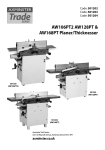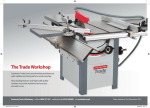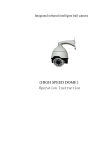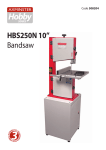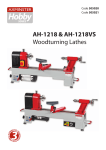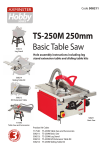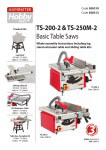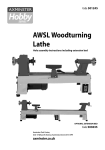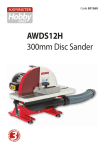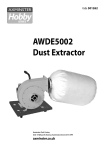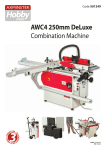Download Axminster WS1000TA Specifications
Transcript
Code: 501209 WS1000TA Spindle Moulder Axminster Tool Centre, Unit 10 Weycroft Avenue, Axminster, Devon EX13 5PH www.axminster.co.uk Index of Contents Page No. Index of Contents Declaration of Conformity What’s Included Optional Accessories General Instructions for 230V Machines Specific Safety Precaution Specifications Assembly Illustration and Parts Description Setting Up the Machine Installing/Changing the Spindle Moulder Cutter Changing the Spindle Moulder Speed Positioning the Machine Using a Sanding Drum Operating Instructions Optional Accessories Routine Maintenance Trouble Shooting Wiring Diagram Parts List/Drawings 02 02 03-04-05-06 03 06-07 07-08 08 09-10-11-12-13-14-15-16 17-18-19-20-21 22-23 24 25 26 26-27 27 28-29 29 30 31 32-33-34-35-36-37-38-39-40-41-42-43 Declaration of Conformity Copied from CE Certificate The undersigned G. Reimann, authorised by Laizhou Planet Machinery Co., Ltd. Yutai West Street Laizhou, Shandong 261400 P.R. China Model number MX5110A manufactured by Laizhou Planet Machinery Co. is in compliance with the following standards or standardisation documents in accordance with Council Directives 2006/42/EC 2006/95/EC symbols below advise that you follow the correct Warning The safety procedures when using this machine. Fully read manual and safety instructions before use 02 Ear protection should be worn Eye protection should be worn Dust mask should be worn HAZARD Motor gets hot What’s Included Quantity 1 off Item Spindle Moulder Support Table Assembly 1 off Support Table 2 off Lift & Shift Handles with Washers (M8 Thread) 1 off Pre-drilled Steel Plate Model Number A C C1 C2 C3 Spindle Guard Assembly 1 off Spindle Guard with Adjustable Fence 2 off Lift & Shift Handles with washers M8 x 140mm 1 off Guide Assembly Mounting Bracket D D1 D2 D3 Guide Assembly 1 off Guide Arm 1 off M8 Clamping Knob 1 off Lift & Shift Handles with Washers (M8 Thread) 1 off Guide Roller Assembly 1 off Anti-Kickback Assembly E E1 E2 E3 E4 E5 Mitre Fence Work Clamp Assembly F 1 off Mitre Fence Casting with Fence 1 off Work Clamp 1 off Pre-drilled Metal Plate with Pointer 1 off M10 Clamping Knob with Washer 1 off Lift & Shift Handle with Washer (M10 Thread) 1 off 10mm Allen Key & 4mm Double Ended Allen Key 1 off Instruction Manual MX5110A F1 F2 F3 F4 F5 Optional Accessories Tenon Plate (Order No: 950506) Sliding Table Extension Assembly (Order No:950505) 1 off 1 off 2 off 1 off 2 off 1 off 1 off Extension Table Extension Table Fence (Adjustable) Lift & Shift Handles with Washers (M6 Thread) Pre-drilled Steel/Pin Plate M6 x 11mm Caphead screws & washers Pivot Arm with four bolts & washers Extension Table Support Rod B B1 B2 B3 B4 B5 B6 B7 03 What’s Included A B6 B7 B B1 B5 B4 B3 B2 04 What’s Included C C3 C2 C1 D D1 D3 D2 E E4 E5 E1 E3 E2 05 What’s in the Box F F4 F2 F4 F3 F1 General Instructions for 230V Machines Good Working Practices/ Safety The following suggestions will enable you to observe good working practices, keep yourself and fellow workers safe and maintain your tools and equipment in good working order. WARNING! KEEP TOOLS AND EQUIPMENT OUT OF THE REACH OF YOUNG CHILDREN! Mains Powered Tools supply the current that is required for your machine. Primary Precautions Work Place/Environment This machine is supplied with a moulded 16 Amp. Plug and 3 core power cable. Before using the tool inspect the cable and the plug to make sure that neither are damaged. If any damage is visible have the tool inspected/repaired by a suitably qualified person. If it is necessary to replace the plug, it is preferable to use an ‘unbreakable’ type that will resist damage on site. Only use a 16 Amp plug, and make sure the cable clamp is tightened securely. Fuse as required. If extension leads are to be used, carry out the same safety checks on them, and ensure that they are correctly rated to safely The machine is not designed for sub-aqua operation, do not use when or where it is liable to get wet. Do not use 230V powered tools anywhere within a site area that is flooded and do not trail extension cables across wet areas. 06 Keep the machine clean; it will enable you to more easily see any damage that may have occurred. Do not use any solvents or cleaners, as these may cause damage to any plastic parts or to the electrical components. General Instructions for 230V Machines KEEP THE WORK AREA AS UNCLUTTERED AS IS PRACTICAL. UNDER NO CIRCUMSTANCES SHOULD CHILDREN BE ALLOWED IN WORK AREAS. It is good practice to leave the machine unplugged until work is about to commence, also make sure to unplug the machine when it is not in use, or unattended. Always disconnect by pulling on the plug body and not the cable. Once you are ready to commence work, remove any tools used in the setting operations (if any) and place safely out of the way. Re-connect the machine. Carry out a final check e.g. check the cutting tool is securely tightened in the machine, check you have the correct speed and function set, check that the power cable will not ‘snag’ etc. Make sure you are comfortable before you start work, balanced, not reaching etc. If the work you are carrying out is liable to generate dust or chips, wear the appropriate safety clothing, goggles, gloves, masks etc. If the work operation appears to be excessively noisy, wear ear-defenders. If you wear your hair in a long style, wearing a cap, safety helmet, hairnet, even a sweatband, will minimise the possibility of your hair being caught up in the rotating parts of the machine, likewise, consideration should be given to the removal of rings and wristwatches, if these are liable to be a ‘snag’ hazard. Consideration should also be given to non-slip footwear, etc. If you are allowing another person to use the machine, ensure that they are suitably qualified to use it. Check that cutters are the correct type and size, are undamaged and are kept clean and sharp, this will maintain their operating performance and lessen the loading on the DO NOT WORK WITH CUTTING OR BORING MACHINE OF ANY DESCRIPTION IF YOU ARE TIRED, YOUR ATTENTION IS WANDERING OR YOU ARE BEING SUBJECTED TO DISTRACTION. DO NOT USE THIS MACHINE WITHIN THE DESIGNATED SAFETY AREAS OF FLAMMABLE LIQUID STORES OR IN AREAS WHERE THERE MAY BE VOLATILE GASES. machine. Above all, OBSERVE…. make sure you know what is happening around you, and USE YOUR COMMON SENSE. Specific Safety Precautions Authorised Use This machine is designed for shaping wood and wood derived materials. Machining of other materials is not permitted and may be carried out in specific cases only after consulting with the manufacturer. The proper use also includes compliance with the operating and maintenance instructions given in this manual. The machine must only be used in a technically perfect condition. When working on the machine, all safety mechanisms and covers must be in operation. In addition to the safety requirements contained in these operating instructions and your country’s applicable regulations, you should observe the generally recognized technical rules concerning the operation of woodworking machines. Any other use exceeds authorisation. The machine must be operated only by persons familiar with its operation and maintenance and who are familiar with its hazards. In the event of unauthorised use of the machine, the manufacturer renounces all liability and the responsibility is transferred exclusively to the operator. The required minimum age must be observed. 07 Specific Safety Precautions General Safety Notes Wear safety shoes; never wear leisure shoes or sandals. Woodworking machines can be dangerous if not used properly. Therefore the appropriate general technical rules as well as the following notes must be observed. Always wear the approved working outfit. Read and understand the entire instruction manual before attempting assembly or operation. For the safe handling of cutting tools wear work gloves. Keep these operating instructions close by the machine, protected from dirt and humidity, and pass them over to the new owner if you part with the tool. Do not wear gloves while operating the machine. Control the stopping time of the machine, it may not exceed 10 seconds. No changes to the machine may be made. Remove cut and jammed workpieces only when the machine is at a complete standstill and motor is turned off. Daily inspect the function and existence of the safety appliances before you start the machine. Install the machine so that there is sufficient space for safe operation and workpiece handling. Remove all loose clothing and enclose long hair. Keep work area well lit. Before operating the machine, remove tie, rings, watches, other jewellery, and roll up sleeves above elbows. Specifications Model Product Code Rating Power Spindle Travel Spindle Diameter Max Spindle Projection above Table Max Tooling Diameter Above Table Max Tooling Diameter Below Table Table Height Table Size Min Extraction Airflow Required Dust Extraction Outlet Overall L x W x H Weight 08 WS1000TA 501209 Trade 2.8kW (230V, 1ph) 100mm 30mm 100mm 200mm 180mm 900mm 1,000 x 360mm 1,000m³/hr 100mm x 2 1,010 x 690 x 900mm 218kg Assembly PLEASE NOTE. Some of this assembly procedure is best accomplished by two persons. Although the tasks are not impossible, some of the items are heavy and awkward, and a mishandling error could cause injury. Please think about what you are doing, your capabilities and your personal safety. Unpack all the boxes and check all the components against the “What's in the Boxes' List. If any parts or components are missing, please contact our customer services department using the procedures and telephone numbers listed in our catalogue, and you will be dealt with quickly and efficiently. Having unpacked the boxes, (please dispose of any unwanted packaging responsibly), put the parts and components whereby they are readily to hand. Break down the main box by knocking the sides away (be careful of exposed nails etc.), but leave the machine sitting on its pallet. Remove the protective grease film that is coating all the unpainted parts of the machine. Use a proprietary de-greasing agent or paraffin et al. Unfortunately, this cleaning process is always a bit ‘mucky’ especially if you tackle the job with a high level of enthusiasm. You are advised to wear overalls or coveralls etc., during the process. After cleaning, especially if you used paraffin, lightly coat the exposed metal surfaces to prevent any rusting. Note: The WS1000TA spindle moulder comes 95% assembled, in order to reduce the footprint of the machine for packaging, several items are dismounted from the machine and need to be re-affixed. Step 1 Support Table Assembly Locate the support table (C1), the two lift and shift handles with M8 washer (C2) & the pre-drilled steel plate (C3). Line up the pre-drilled holes in the steel plate (C3) with holes in the bench casting (C1) and screw the two lift and shift handles (C2) through. Note: leave at least a 3mm gap between the plate (C3) & the support table (C1) for the next stage (See figs 1 & 2). Fig 1 C1 C2 Fig 2 C3 Screw the two lift and shift handles C2 through the both C1 & C3 Keep at lest a 3mm gap between the steel plate C3 and support table C1 09 Assembly Line up the edge of the steel plate (C3) with the ‘T’ slot machined into the sliding table A see fig 3. Slide the support table assembly (C) onto the sliding table & position it to the far side. Tighten the two lift and shift handles (C2) to clamp the assembly in position (See fig 4). Fig 3 C Fig 4 C2 A Slide the table assembly C1 onto the sliding table A Clamp the table in position by tightening the two lift and shift handles C2 Step 2 Sliding Table Extention Assembly (Optional Accessory Order No: 950505) Locate the pivot arm (B6) with the four bolts & washers, line the holes in the mounting bracket with pre-drilled holes to the side of the spindle moulder (A) & secure using the bolts and washers (See figs 5-6). Locate the extention table support rod (B7), slide the support rod (B7) through the pre-drilled hole in the pivot arm (B6) and secure using the nuts & washers (See figs 7-8). Fig 5 B6 Line up pivot arm bracket to the side of the machine 10 Continues Over.... Locate the extention table (B1), extention table fence (B2), lift and shift handles with M6 washers (B3) & the pre-drilled steel pin plate (B4). Fig 6 Slide the steel pin plate into the machined ‘T’ slot to the left hand side of the sliding table (See fig 9). Pull out the extention table support arm (B6) see figs 10 and 11, offer up the machined slots in the table (B1) with the pins (B4), see figs 12 and 13, locate the two lift and shift handles (B3) and screw them through the pre-drilled holes in the table (B1) into the pre-drilled steel pin plate (B4), see fig 14. Tighten the lift and shift handles (B3). Using a spanner, tighten the five bolts Assembly Fig 7 Fig 8 B7 B6 Nuts & washers Fig 9 Fig 10 A B4 B6 ‘T’ slot Machined slots Fig 11 Fig 12 B1 Pre-drilled holes Pins Fig 13 Fig 14 B1 A B3 11 Assembly Fig 15 B5 Fig 16 Straght edge Adjustment screw 5mm Allen Key Locate the two M6 x 11mm caphead screws (B5), line up the extention table support rod (B7) bracket with the pre-drilled holes in the extention table (B1), using the two M6 caphead screws and a 5mm allen key secure the support rod (B7) to the table (B1) (See fig 15). On top of the extention table there are two adjustment grub screws, using a straight edge adjust the screws using a 4mm allen key until both sliding and extention tables are level (See fig 16). (Note: Turn clockwise to raise the extention table, counterclockwise to lower it). Fig 17 Fig 18 Place a level on the extention table (B1) and using two spanners adjust the four nuts on the support rod (B7) until the extention table (B1) is level (See figs 17 and 18) Lift up the left 90˚ degree stop, see fig 19, locate the extention table fence assembly (B2), lower the fence assembly onto the table casting (B1) making sure the pin beneath the fence inserts into the pre-drilled hole on top of the table casting (B1), see figs 20 and 21. Push the fence up-against the 90˚ stop, position the angle bracket (a) up-against the table casting B1 and turning butterfly knob clamps the fence (B2) to the table casting (B1) (See fig 22). Lastly tighten the lift and shift handle (b) to prevent the pin from moving (See figs 22). Note: The fence (B2) can be mounted to the opposite side of the table casting (B1) in the same way as described above. 12 Continues Over.... Assembly 90˚ Stop Fig 19 Fig 20 B2 B1 Pin Fig 21 Fig 22 (b) Lift & shift handle pin lock Turning the handle to lock pin (a) Turn butterfly knob to lock the fence Step 3 Spindle Guard Assembly Locate the spindle guard (D1) and the two M8 x 140mm lift & shift handles with washers (D2). Raise the spindle to the maximum height by unlocking the spindle moulder rise/fall locking handle (a) and turning the spindle moulder rise/fall wheel clockwise (b) then lock in place (See figs 23-24). Remove the circular rings from the work table and place aside, see fig 25, Lower the spindle guard (D1) onto the work surface & line up the machined slots in the guard casting (D1) with the two pre-drilled holes on either side of the spindle (See figs 24-26). Put to hand the lift & shift handles (D2), slide each one through the machined slot in the guard casting (D1) and screw them into the pre-drilled holes on the spindle table, locking the guard (D1) in position (See figs 27-28). Fig 23 (a) Fig 24 (b) Pre-drilled holes 13 Assembly Fig 25 Circular rings Fig 26 D1 Fig 27 Fig 28 D1 D2 Locate the guide assembly mounting bracket (D3), using a 6mm allen key remove the four caphead bolts & washers on top of the spindle guard (D1), place safely aside (See fig 29). Lower the guide assembly mounting bracket (D3) on top of the spindle guard & line up the four pre-drilled holes, replace the caphead bolts & washers you removed earlier and tighten (See fig 30) (DO NOT OVERTIGHTEN). Fig 29 Caphead bolts & washers 6mm Allen key 14 D3 Fig 30 Assembly Step 4 Guide Assembly Locate the guide arm (E1) and slide it through the mounting bracket (D3), with two thirds extending out for the front of the guard, clamp in place using the M8 clamping knob (E2) and lift and shift handle (E3) (See figs 31-32). Locate the feeder roller assembly (E4) and slide it onto the guide arm (E1), clamp in place using the clamping knob (See fig 33). Locate the anti-kickback assembly (E5) and repeat as before (See fig 34). (NOTE: Make sure metal wave plate is facing inwards) D3 Fig 31 E3 Fig 32 E2 E1 Slide the guide arm (E1) through the mounting bracket (D3) E4 Fig 33 Slide on the guide roller assembly (E4) and clamp in position Clamp the guide arm with the clamping knob (E2) and lift and shift handle (E3) E5 Fig 34 Slide the anti-kickback assembly (E5) and clamp in position Continues Over.... 15 Assembly Step 5 Mitre Fence Work Clamp Assembly Locate the pre-drilled metal plate (F3) & slot it into the machined ‘T’ slot in the sliding table (See figs 35-36). Lower the mitre fence casting (F1) on top of the metal plate (F3), line up the machined slot & pre-drilled hole in the mitre fence casting with the holes in the metal plate, see fig 37, locate the M10 clamping knob (F4) with washer & screw it through the hole in the casting into the metal plate (F3) (See fig 38). Locate the lift and shift handle (F5) and screw it through the machined slot into the remaining pre-drilled hole and lightly tighten (See fig 39). Lastly locate the work clamp (F2) and slide it onto the steel rod, clamp in place by tightening the clamping knob (See fig 40). (DO NOT OVERTIGHTEN) ‘T’ Slot Fig 35 Fig 36 F3 F4 F1 Fig 37 Fig 38 F5 Fig 39 16 F2 Fig 40 Illustration & Parts Description D E F A C B A Spindle Moulder D Spindle Guard Assembly B Sliding Table Extention Assembly Optional E Guide Assembly Accessory (Order No: 950505) F Mitre Fence Work Clamp Assembly C Sliding Bench Assembly 17 Illustration & Parts Description E5 Anti-kickback assembly E4 Guide roller assembly F2 Work clamp Mitre fence F5 Lift & shift handle D1 Spindle guard with adjustable fence Sliding table handle Work table Sliding table C1 Steel bench B1 Extension table casting B2 Extension table fence Motor access door Dust extractor B6 Pivot arm 18 B7 Extension table casting support rod Illustration & Parts Description Guide roller clamping knob E2 Clamping knob E3 Lift & shift handle Anti-kickback clamping knob E1 Guide arm Guide roller height clamping knob D3 Guide assembly bracket Anti-kickback height clamping knob D2 Lift & shift handle Fence advancing knob Fence adjusting knob Fence advancing clamping knob Dust extraction outlet Spindle tilt lock handle Spindle height lock Tilt scale Spindle height operating wheel Spindle speed indicator Spindle height scale 19 Illustration & Parts Description Fig 41 Fig 42 Off On Spindle moulder control panel Fig 43 NVR ON/OFF switch Fig 44 Reversing selector switch Emergency stop shroud, slap the shroud down to stop the machine. NOTE: The machine is equipped with a FORWARD/REVERSE switch as shown in figure 43. You will find many instances that it is necessary to flip the cutter over and reverse the cutter rotation. CAUTION: BEFORE TURNING THE SELECTOR SWITCH, MAKE SURE THE MACHINE IS AT A COMPLETE STOP! NOTE: Turning the reversing selector switch to the (L) position the motor will run in a forward motion & the spindle will turn counter-clockwise. Turning the selector switch to the (R) position the motor will run reverse & the spindle will turn clockwise (See fig 43). Fig 45 Sliding table locking knob, locked in the out position 20 Fig 46 Pull the locking knob & twist Illustration & Parts Description Fig 47 Fig 48 The extension table fence set to 45˚ Magnifying glass Extension table angle scale Butterfly clamping knob Fig 49 Fig 50 Distance stop clamp Distance stop assembly Telescopic extension assembly Fig 51 Fig 52 a Spindle moulder table height adjusting nuts (a) Fig 53 b Sliding table height adjusting nuts (b) Fig 54 Extension table 90˚ stop Spindle tilt operating handle, located to the front of the machine 21 Setting Up the Machine Setting the fence The fence is a two piece adjusting system. Each fence is independently adjustable to compensate for different cutting thicknesses. Make sure the fence is square to the work surface, place a 90˚ square up against the fence and check it is perpendicular to the work surface. If it is not, turn the fence adjusting knob (a) until it is correct (See figs 55 and 56). Place a straight edge up-against the fence, loosen the fence advancing clamping knobs & turn the fence advancing knobs (b) until both fences are aligned (See figs 57 & 58). Fig 55 A Fig 56 Place a 90˚square up against the fence and check it is perpendicular Fig 57 Adjust the advancing knobs (b) until both fences are aligned B Fig 58 Place a straight edge up-against the fences and check they are aligned Adjust the position of the fence assembly to give both the required cutter protrusion and adequate clearance between the cutter and the fence. Close up the aluminum fences to give approximately 5mm clearance around the cutter (see fig 59). The fence is used to guide small workpieces through the cutter without them being trapped between the fence and the cutter. The dust extraction hose is connected to the aperture at the rear of the fence casting. Before starting work, carefully check that the cutter can rotate freely without fouling the inside of the guard and that the guard is clamped firmly in place. 22 Setting up the Machine Fig 59 5mm Adjusting the feeder roller & ant-kickback assembly Loosen the feeder roller clamping knobs (a and b) & move the feeder roller to the centre of the workpiece, tighten the clamping knobs. Undo the anti-kickback clamping knobs (c and d) and move the assembly near the workpiece, tighten the clamping knob (c), raise the assembly so the steel plate is about 5-10mm above the work table (See figs 60 & 61). A Fig 60 Fig 61 c d b 5-10mm Leveling the sliding table Place a level between the sliding table & work table & check that both tables are level. If not loosen the three nuts (e) beneath the sliding table and adjust the two coach bolts (f ), until the bubble on the level is between the two markers (g), tighten the three nuts (e) (See figs 62 & 63). F Fig 62 Fig 63 G E 23 Installing/Changing the Spindle Moulder Cutter DISCONNECT THE MACHINE FROM THE MAINS SUPPLY! Raise the spindle to the maximum height by unlocking the spindle moulder rise/fall locking handle and turning the spindle moulder rise/fall handle clockwise then lock in place. Using a 19mm spanner remove the bolt & clamping block (D), spacing collar/s (E) and clamping washer (F) and place them safely aside, remove the cutter block. Check the new cutter block for damage,sharpness etc. Fit the new cutter block on the arbor as low as possible, see fig 1and 2. Watch the direction of rotation (counter-clockwise) when mounting the cutter. replace the clamping washer (F), spacing collar/s (E), clamping block (D) and bolt. Tighten the clamping block securely (See figs 64,65,66 &67). F E Fig 64 E Fig 65 D Cutter block Fig 66 D 19mm Spanner Fig 67 Spindle (arbor) F E Changing the spindle moulder cutter Turn the cutter block once by hand to check it doesn't foul anywhere. Reconnect the machine to the mains supply. Give the machine a 'quick' burst check ( i.e. quick ON-OFF) to ensure everything is O.K. If everything is satisfactory, continue to use the machine. Check the old cutter block for damage, sharpness, resin buildup, etc., clean if necessary and send for refurbishment/resharpening if required. If the cutter block is not to be re-sharpened, clean and pack away in its stowage case. Fig B Fig A The cutter block must be positioned on the arbor as low as possible. (See fig A) 24 Changing the Spindle Moulder Speed DISCONNECT THE MACHINE FROM THE MAINS SUPPLY! Open the motor access door to the front of the machine, by removing the two caphead screws, see figs 68 & 69, lower the spindle to it’s lowest point, if not done so already. Locate the 10mm allen key (G), loosen the caphead bolt (H) on top of the motor, pull the motor tension lever (I) out, to allow the belt to go slack & reposition the belt on the pulleys as required. When you are happy push back the tension lever (I) and tighten the caphead bolt (H) to keep the tension (See figs 70,71 & 72). Caphead screw Motor access door Fig 68 Fig 69 G Fig 70 Fig 71 H I Fig 72 Close the access door, raise the spindle, reconnect the machine to the mains supply. Give the machine a 'quick' burst check ( i.e. quick ON-OFF) to ensure everything is O.K. If everything is satisfactory, continue to use the machine. 25 Positioning the Machine Note: Ascertain the orientation of the machine and move it to its desired position in the workshop. Ensure that the machine is positioned to allow sufficient clearance both in front, behind and to the sides of the machine to cater for the maximum length of timber you will wish to machine. The machine should be positioned on a flat level surface. Once the machine is in position, and level, it can be bolted to the floor if so required. SAFETY WARNING! 218kg Max Weight ! The WS1000TA Spindle Moulder is a heavy piece of equipment. You are advised to seek help or the use of some form of lifting device, (hoist, engine crane etc.,) before you attempt to lift or move this machine. DO NOT Lift the sliding tables Using a Sanding Drum DISCONNECT THE MACHINE FROM THE MAINS SUPPLY! The spindle moulder can be used as a sander by attaching a sanding drum to the spindle, please follow the instruction below. Warning: When using the sanding drum, the spindle speed should not exceed 1800 rpm. •Raise the spindle to the maximum height by unlocking the spindle moulder rise/fall locking handle and turning the spindle moulder rise/fall handle clockwise then lock in place. •Remove the spindle guard & guide assembly, place safely aside. •Remove the cutter block as described on page 23, insert the sanding drum (a) into the sanding sleeve (b). • Place a spacing collar (c) & the sanding drum assembly onto the spindle, place a further spacing collar (c) on top sanding drum assembly. Secure using the clamping block (d) & bolt (e), tighten with a 19mm spanner (DO NOT OVERTIGHTEN) (See fig 73). 26 Using a Sanding Drum Sanding drum assembly Fig 73 Operating Instructions Workpiece Handling •Feed the workpiece straight across the machine table, holding the fingers close together and guiding the workpiece with the palms of your hands. •Never put your hands under or behind the cutter guard. •Always keep your hands well clear of the rotating cutter. •Always feed the workpiece against the cutter rotation as shown by the arrow in illustration. •Use a push stick when working the ends of narrow stock. •Use a feeding aid if you are going to machine a workpiece shorter than 300mm. •Always machine the workpiece over its entire length. Recess machining may only be carried out with the aid of suitable longitudinal workpiece stops. •When working complex shapes, make jigs and guides to guide the workpiece properly and safely. •Make trial cuts on a piece of scrap before working the actual workpiece. •Support long workpieces with roller stands or table extensions. •Always work one workpiece at a time. Correct operating position Position yourself offset to the machine as shown. 27 Optional Accessories The spindle moulder can be fitted with the following optional accessories: • Sliding Table Extension Order No: 950505 See fig 74) This accessory is a support table complete with a telescopic support arm. It clamps to the sliding table to provide extra support when machining panels or the ends of long boards. Supplied with a long fence arm and length stop. The telescopic arm requires mounting to the machines chassis using the mounting hole provided. Some care should be taken when mounting the arm to ensure that the table stays level throughout its travel. • Tenon Plate Order No: 950506 (See fig 75) This accessory is a simple alloy plate that lifts the work piece above the table. This means that you can machine the top and bottom surface of the work, such as when creating a tenon. It can be mounted next to the mitre fence and clamp so as to make the machining of end grain material as safe as possible. A medium weight power feed unit with three white rubber rollers, all spring-loaded to provide a constant feed rate on either a planer, saw bench or spindle moulder. There is a choice of four feed speeds, easily selectable by removing the side plate and re-positioning the drive gears. The horizontal and vertical position of the drive head can be precisely adjusted with the aid of the two adjusting screws and then securely locked in place with the two handles. An additional feature is the ability to rotate the head through 90° so that pressure can be applied to the work in either the vertical or horizontal planes. The unit is secured to the table of the machine, either by bolting through or by screwing into holes tapped into the cast iron bed. If drilling the holes into the table of your machine is too disheartening then the purchase of the universal quick fix support plate (800430) is an excellent solution. The plate bolts onto the corner of a table and is clamped in place with the bolts provided. The top of the plate is drilled and tapped to accept all of the power feed units we offer, allowing the unit to be bolted on to whichever machine it is required on. •Co-Matic AF32 Junior Power Feed Order No: 340195 (See figs 76 & 77) Fig 74 Sliding Table Extension Assembly 28 Fig 75 Tenon Plate Optional Accessories Fig 76 Fig 77 Co-Matic AF32 Junior Power Feed in operation Co-Matic AF32 Junior Power Feed Routine Maintenance DISCONNECT THE MACHINE FROM THE MAINS SUPPLY! Spindle Moulder • Keep the cutter block clean and free from dust build up. • Check the cutter block regularly for chipped blades and damage to block i.e cracks in the cutter block. • When changing the cutter block, remove the cutter block and place safely away, clean the spindle by spraying a light coating of oil over the shaft and install a new cutter block. •Opening the access door for the spindle moulder, check the belt tension. If the belt is loose, using the 10mm allen key lossen the motor caphead bolt and push/pull until the belt is under tension again, tighten the motor bolt to keep the tension. • If the “Spindle Moulder” is not going to be used for a period of time spray, a light coat of oil over the table service and blades, this will help prevent rust and place a dust sheet over the spindle moulder. Major Service After several months of constant use the condition of the chains, sprockets and tension of the drive belts and the treaded drive shafts of the rise and fall tilt mechanisms will need to be checked, that will require a service engineer to see over the job. If you find that the machine is not performing as it should please contact “Axminster Tool Centre” by phone on 0800 371822. 29 Trouble Shooting DISCONNECT THE MACHINE FROM THE MAINS SUPPLY! 30 Wiring Diagram 31 Parts List/Drawings 32 Parts List/Drawings 33 Parts List/Drawings 34 Parts List/Drawings 35 Parts List/Drawings 36 Parts List/Drawings 37 Parts List/Drawings 38 Parts List/Drawings 39 Parts List/Drawings 40 Parts List/Drawings 41 Parts List/Drawings 42 Parts List/Drawings 43 Please dispose of packaging for the product in a responsible manner. It is suitable for recycling. Help to protect the environment, take the packaging to the local recycling centre and place into the appropriate recycling bin. Only for EU countries Do not dispose of electric tools together with household waste material. In observance of European Directive 2002/96/EC on waste electrical and electronic equipment and its implementation in accordance with national law, electric tools that have reached the end of their life must be collected separately and returned to an environmentally compatible recycling facility.












































